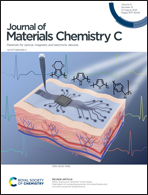Attaining air stability in high performing n-type phthalocyanine based organic semiconductors†
Abstract
The perfluorinated analogue of silicon phthalocyanine (F2-F16SiPc) has been synthesized as a novel air-stable n-type organic semiconductor. The design of F2-F16SiPc facilitates strong electron conduction through peripheral fluorination that deepens molecular orbital energies, while contributing to an extensive network of π⋯π′ and F⋯F′ interactions that promote a highly symmetric three-dimensional assembly as determined via single-crystal X-ray diffraction. When incorporated into organic thin-film transistors (OTFTs), electron mobilities for F2-F16SiPc-based devices reached performances on par with current benchmark phthalocyanine-based devices under inert environments (up to 0.30 cm2 V−1 s−1), while surpassing performances under atmospheric conditions (up to 0.17 cm2 V−1 s−1). These observations highlight the impact molecular and crystallographic engineering has in the development of organic-based electronics, as the F2-F16SiPc building block lays new grounds for the development of air-stable n-type OTFTs.



 Please wait while we load your content...
Please wait while we load your content...